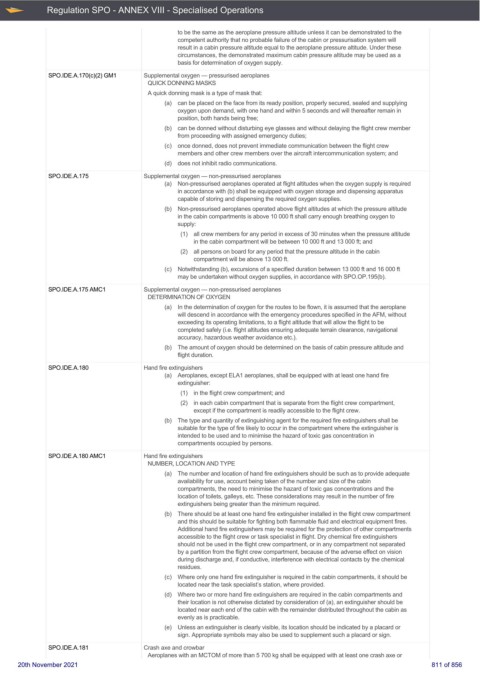Page 811 - UK Air Operations Regulations 201121
P. 811
~
~ Regulation SPO - ANNEX VIII - Specialised Operations Centrik
to be the same as the aeroplane pressure altitude unless it can be demonstrated to the
competent authority that no probable failure of the cabin or pressurisation system will
result in a cabin pressure altitude equal to the aeroplane pressure altitude. Under these
circumstances, the demonstrated maximum cabin pressure altitude may be used as a
basis for determination of oxygen supply.
SPO.IDE.A.170(c)(2) GM1 Supplemental oxygen — pressurised aeroplanes
QUICK DONNING MASKS
A quick donning mask is a type of mask that:
(a) can be placed on the face from its ready position, properly secured, sealed and supplying
oxygen upon demand, with one hand and within 5 seconds and will thereafter remain in
position, both hands being free;
(b) can be donned without disturbing eye glasses and without delaying the flight crew member
from proceeding with assigned emergency duties;
(c) once donned, does not prevent immediate communication between the flight crew
members and other crew members over the aircraft intercommunication system; and
(d) does not inhibit radio communications.
SPO.IDE.A.175 Supplemental oxygen — non-pressurised aeroplanes
(a) Non-pressurised aeroplanes operated at flight altitudes when the oxygen supply is required
in accordance with (b) shall be equipped with oxygen storage and dispensing apparatus
capable of storing and dispensing the required oxygen supplies.
(b) Non-pressurised aeroplanes operated above flight altitudes at which the pressure altitude
in the cabin compartments is above 10 000 ft shall carry enough breathing oxygen to
supply:
(1) all crew members for any period in excess of 30 minutes when the pressure altitude
in the cabin compartment will be between 10 000 ft and 13 000 ft; and
(2) all persons on board for any period that the pressure altitude in the cabin
compartment will be above 13 000 ft.
(c) Notwithstanding (b), excursions of a specified duration between 13 000 ft and 16 000 ft
may be undertaken without oxygen supplies, in accordance with SPO.OP.195(b).
SPO.IDE.A.175 AMC1 Supplemental oxygen — non-pressurised aeroplanes
DETERMINATION OF OXYGEN
(a) In the determination of oxygen for the routes to be flown, it is assumed that the aeroplane
will descend in accordance with the emergency procedures specified in the AFM, without
exceeding its operating limitations, to a flight altitude that will allow the flight to be
completed safely (i.e. flight altitudes ensuring adequate terrain clearance, navigational
accuracy, hazardous weather avoidance etc.).
(b) The amount of oxygen should be determined on the basis of cabin pressure altitude and
flight duration.
SPO.IDE.A.180 Hand fire extinguishers
(a) Aeroplanes, except ELA1 aeroplanes, shall be equipped with at least one hand fire
extinguisher:
(1) in the flight crew compartment; and
(2) in each cabin compartment that is separate from the flight crew compartment,
except if the compartment is readily accessible to the flight crew.
(b) The type and quantity of extinguishing agent for the required fire extinguishers shall be
suitable for the type of fire likely to occur in the compartment where the extinguisher is
intended to be used and to minimise the hazard of toxic gas concentration in
compartments occupied by persons.
SPO.IDE.A.180 AMC1 Hand fire extinguishers
NUMBER, LOCATION AND TYPE
(a) The number and location of hand fire extinguishers should be such as to provide adequate
availability for use, account being taken of the number and size of the cabin
compartments, the need to minimise the hazard of toxic gas concentrations and the
location of toilets, galleys, etc. These considerations may result in the number of fire
extinguishers being greater than the minimum required.
(b) There should be at least one hand fire extinguisher installed in the flight crew compartment
and this should be suitable for fighting both flammable fluid and electrical equipment fires.
Additional hand fire extinguishers may be required for the protection of other compartments
accessible to the flight crew or task specialist in flight. Dry chemical fire extinguishers
should not be used in the flight crew compartment, or in any compartment not separated
by a partition from the flight crew compartment, because of the adverse effect on vision
during discharge and, if conductive, interference with electrical contacts by the chemical
residues.
(c) Where only one hand fire extinguisher is required in the cabin compartments, it should be
located near the task specialist’s station, where provided.
(d) Where two or more hand fire extinguishers are required in the cabin compartments and
their location is not otherwise dictated by consideration of (a), an extinguisher should be
located near each end of the cabin with the remainder distributed throughout the cabin as
evenly as is practicable.
(e) Unless an extinguisher is clearly visible, its location should be indicated by a placard or
sign. Appropriate symbols may also be used to supplement such a placard or sign.
SPO.IDE.A.181 Crash axe and crowbar
Aeroplanes with an MCTOM of more than 5 700 kg shall be equipped with at least one crash axe or
20th November 2021 811 of 856

